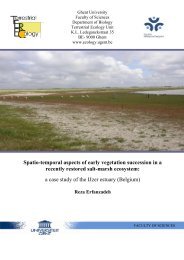PhD Arthur Decae 2010 - Ghent Ecology - Universiteit Gent
PhD Arthur Decae 2010 - Ghent Ecology - Universiteit Gent
PhD Arthur Decae 2010 - Ghent Ecology - Universiteit Gent
You also want an ePaper? Increase the reach of your titles
YUMPU automatically turns print PDFs into web optimized ePapers that Google loves.
laterally. Chelicerae strong, color and setae as in male. Rastellum more strongly developed<br />
than in male. Fang keel serrated (Fig. 7) or rarely smooth (in one specimen). Ventral aspect<br />
(Fig. 27).<br />
Maxillae with small anterior apical process, cuspules well developed, in irregular rows.<br />
Sternum (1/w =1.4-1.6), posterior sigilla oval, about their largest diameter from sternum edge,<br />
anterior and median sigilla hardly visible. Labium with anterior edge slightly convex. Legs<br />
with very strong spines on anterior metatarsi and tibiae, scopula restricted to tarsi and<br />
metatarsi (no pseudoscopula on tibiae). One or two prolateral spines on patella III (Fig. 30a,<br />
Fig. 26-32. Nemesia bristowei sp. n., female. 26 habitus dorsal; 27 habitus ventral; 28 carapace, lateral; 29<br />
eye-formation, dorsal; 30 patella and tibia III, prolateral (note variation in spine pattern right (a) and left (b);<br />
31 spinnerets, ventral (note vestigial PMS); 32 spermathecae, dorsal. Scale lines = 2mm (26-28), 1mm (30),<br />
0.5mm (29, 31-32).<br />
b), rarely none. Retrolateral apical comb on metatarsus IV not evident in all specimens. Palp<br />
with numerous strong spines and spine pairs on both lateral sides of tibia; scopula restricted to<br />
tarsus. Abdomen light greyish brown with vague, irregular dorsal pattern of darker patches.<br />
Spinnerets (Fig. 31) creamy yellow, PMS vestigial with only one or two fine apical spigots,<br />
conical, PLS apical field spigots grouped around 1-3 macro-spigots. Spermathecae (Fig. 32)<br />
bipartite, slender "mushroom" shape (proximal part of receptacle tubular, distal part globular),<br />
evenly covered with thin glandular tissue.<br />
Burrow (Fig. 69): The burrow of N. bristowei is immediately recognizable by the peculiar,<br />
intricate shape of the trapdoor and burrow rim (Fig. 80). Bristowe (1941: 257) first found and<br />
illustrated this "cogwheel- door". Bristowe 1952 reported that he had not been able to describe<br />
the species, because his collection was destroyed during World War II. It took nearly half a<br />
century before Selden 1997 rediscovered this remarkable trapdoor spider in 1989. The tube of<br />
the burrow has no special features, but is a narrow cylindrical hole (diameter 0.6-0.9cm) about<br />
8-15cm deep, that often widens somewhat near the bottom. The largest diameter of the<br />
trapdoor is about 1.15cm. The walls and bottom of the tube are lined with a dense sheet of<br />
silk. In this respect it is similar to the burrow of N. randa (Fig. 70), but different from that of<br />
N. brauni (Fig. 68), in which only the upper parts of the burrow are lined with silk.<br />
Behavior: Adult N. bristowei females are small, rather shy spiders that have a much more<br />
defensive attitude than N. brauni. The peculiar trapdoor, the construction of which was<br />
described by Bristowe (1941: 257), seems to function to improve the closing of the burrow.










